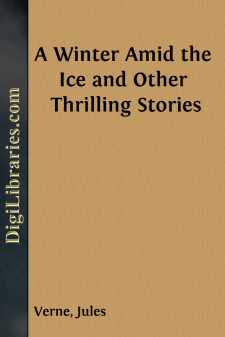Categories
- Antiques & Collectibles 13
- Architecture 36
- Art 48
- Bibles 22
- Biography & Autobiography 813
- Body, Mind & Spirit 142
- Business & Economics 28
- Children's Books 17
- Children's Fiction 14
- Computers 4
- Cooking 94
- Crafts & Hobbies 4
- Drama 346
- Education 46
- Family & Relationships 57
- Fiction 11829
- Games 19
- Gardening 17
- Health & Fitness 34
- History 1377
- House & Home 1
- Humor 147
- Juvenile Fiction 1873
- Juvenile Nonfiction 202
- Language Arts & Disciplines 88
- Law 16
- Literary Collections 686
- Literary Criticism 179
- Mathematics 13
- Medical 41
- Music 40
- Nature 179
- Non-Classifiable 1768
- Performing Arts 7
- Periodicals 1453
- Philosophy 64
- Photography 2
- Poetry 896
- Political Science 203
- Psychology 42
- Reference 154
- Religion 513
- Science 126
- Self-Help 84
- Social Science 81
- Sports & Recreation 34
- Study Aids 3
- Technology & Engineering 59
- Transportation 23
- Travel 463
- True Crime 29
A Winter Amid the Ice and Other Thrilling Stories
by: Jules Verne
Categories:
Description:
Excerpt
CHAPTER I.
HOW IT IS USELESS TO SEEK, EVEN ON THE BEST MAPS, FOR THE SMALL TOWN OF QUIQUENDONE.
If you try to find, on any map of Flanders, ancient or modern, the small town of Quiquendone, probably you will not succeed. Is Quiquendone, then, one of those towns which have disappeared? No. A town of the future? By no means. It exists in spite of geographies, and has done so for some eight or nine hundred years. It even numbers two thousand three hundred and ninety-three souls, allowing one soul to each inhabitant. It is situated thirteen and a half kilometres north-west of Oudenarde, and fifteen and a quarter kilometres south-east of Bruges, in the heart of Flanders. The Vaar, a small tributary of the Scheldt, passes beneath its three bridges, which are still covered with a quaint mediæval roof, like that at Tournay. An old château is to be seen there, the first stone of which was laid so long ago as 1197, by Count Baldwin, afterwards Emperor of Constantinople; and there is a Town Hall, with Gothic windows, crowned by a chaplet of battlements, and surrounded by a turreted belfry, which rises three hundred and fifty-seven feet above the soil. Every hour you may hear there a chime of five octaves, a veritable aerial piano, the renown of which surpasses that of the famous chimes of Bruges. Strangers--if any ever come to Quiquendone--do not quit the curious old town until they have visited its "Stadtholder's Hall", adorned by a full-length portrait of William of Nassau, by Brandon; the loft of the Church of Saint Magloire, a masterpiece of sixteenth century architecture; the cast-iron well in the spacious Place Saint Ernuph, the admirable ornamentation of which is attributed to the artist-blacksmith, Quentin Metsys; the tomb formerly erected to Mary of Burgundy, daughter of Charles the Bold, who now reposes in the Church of Notre Dame at Bruges; and so on. The principal industry of Quiquendone is the manufacture of whipped creams and barley-sugar on a large scale. It has been governed by the Van Tricasses, from father to son, for several centuries. And yet Quiquendone is not on the map of Flanders! Have the geographers forgotten it, or is it an intentional omission? That I cannot tell; but Quiquendone really exists; with its narrow streets, its fortified walls, its Spanish-looking houses, its market, and its burgomaster--so much so, that it has recently been the theatre of some surprising phenomena, as extraordinary and incredible as they are true, which are to be recounted in the present narration.
Surely there is nothing to be said or thought against the Flemings of Western Flanders. They are a well-to-do folk, wise, prudent, sociable, with even tempers, hospitable, perhaps a little heavy in conversation as in mind; but this does not explain why one of the most interesting towns of their district has yet to appear on modern maps.
This omission is certainly to be regretted. If only history, or in default of history the chronicles, or in default of chronicles the traditions of the country, made mention of Quiquendone!...






















